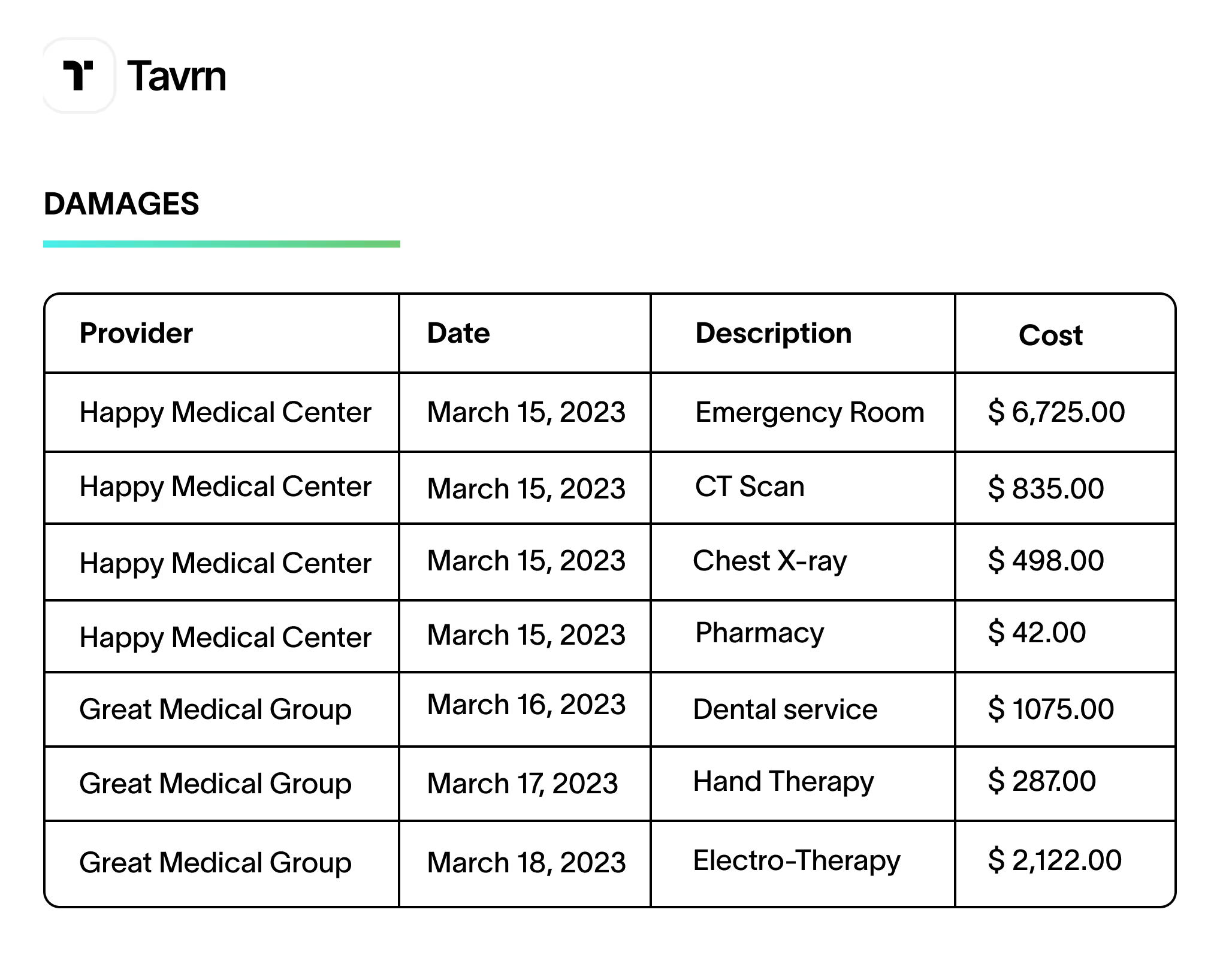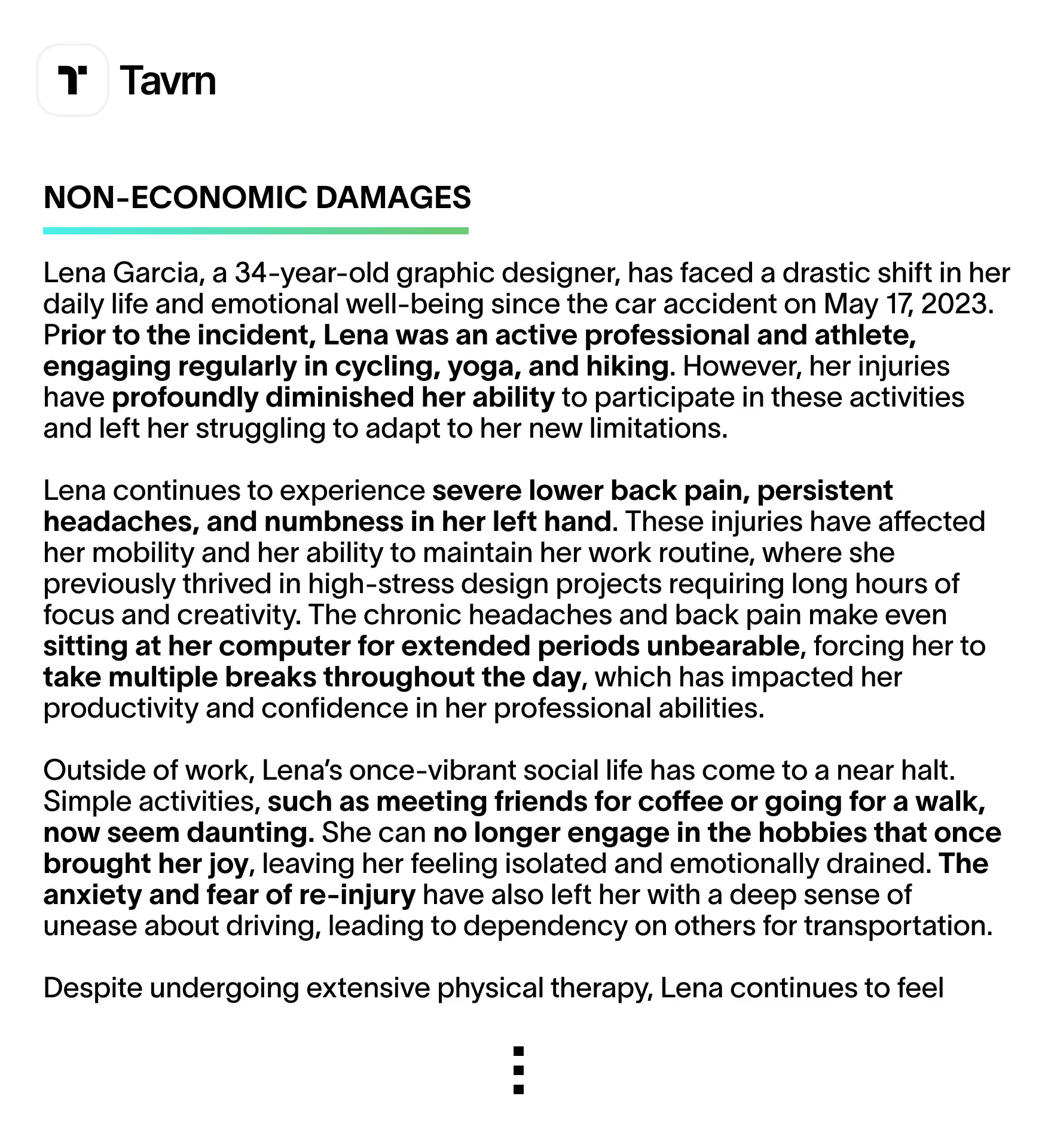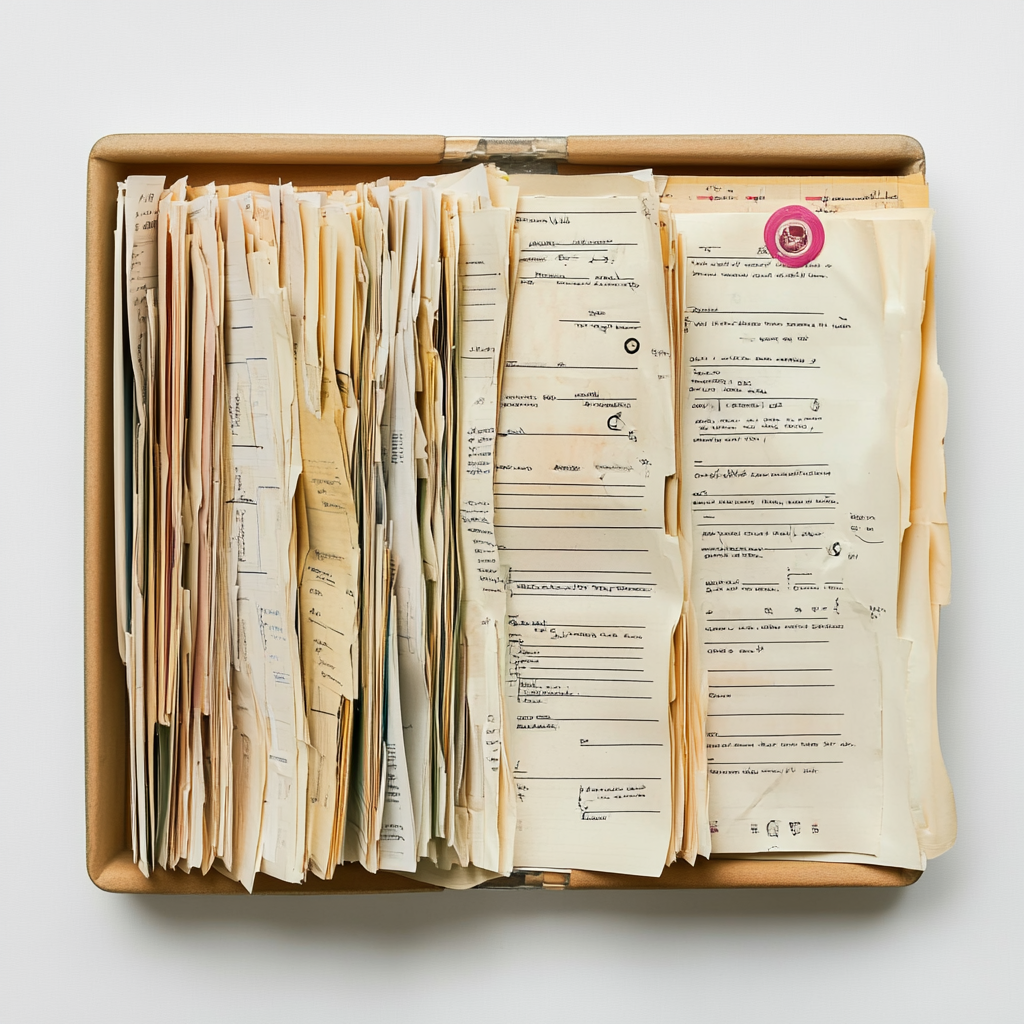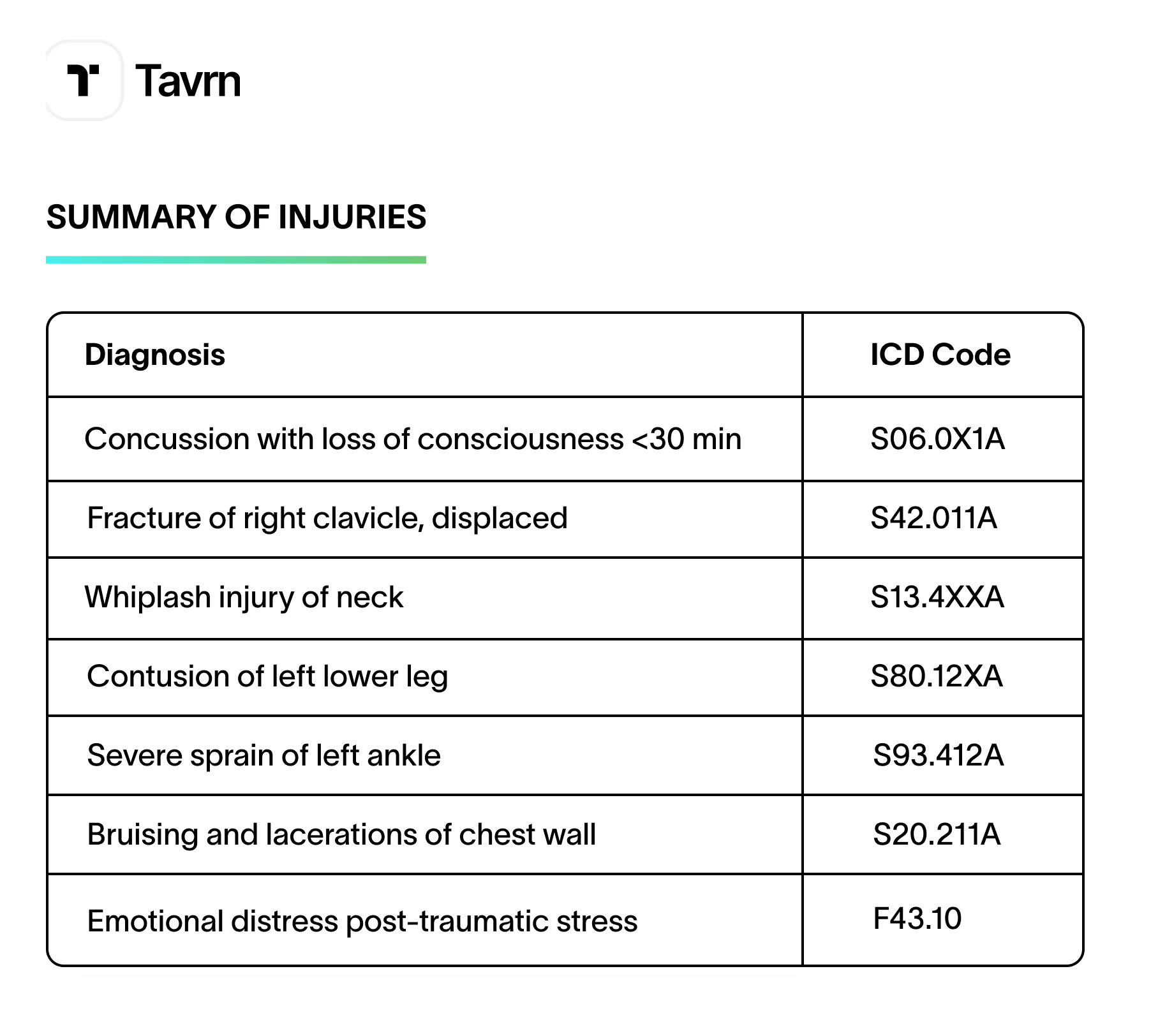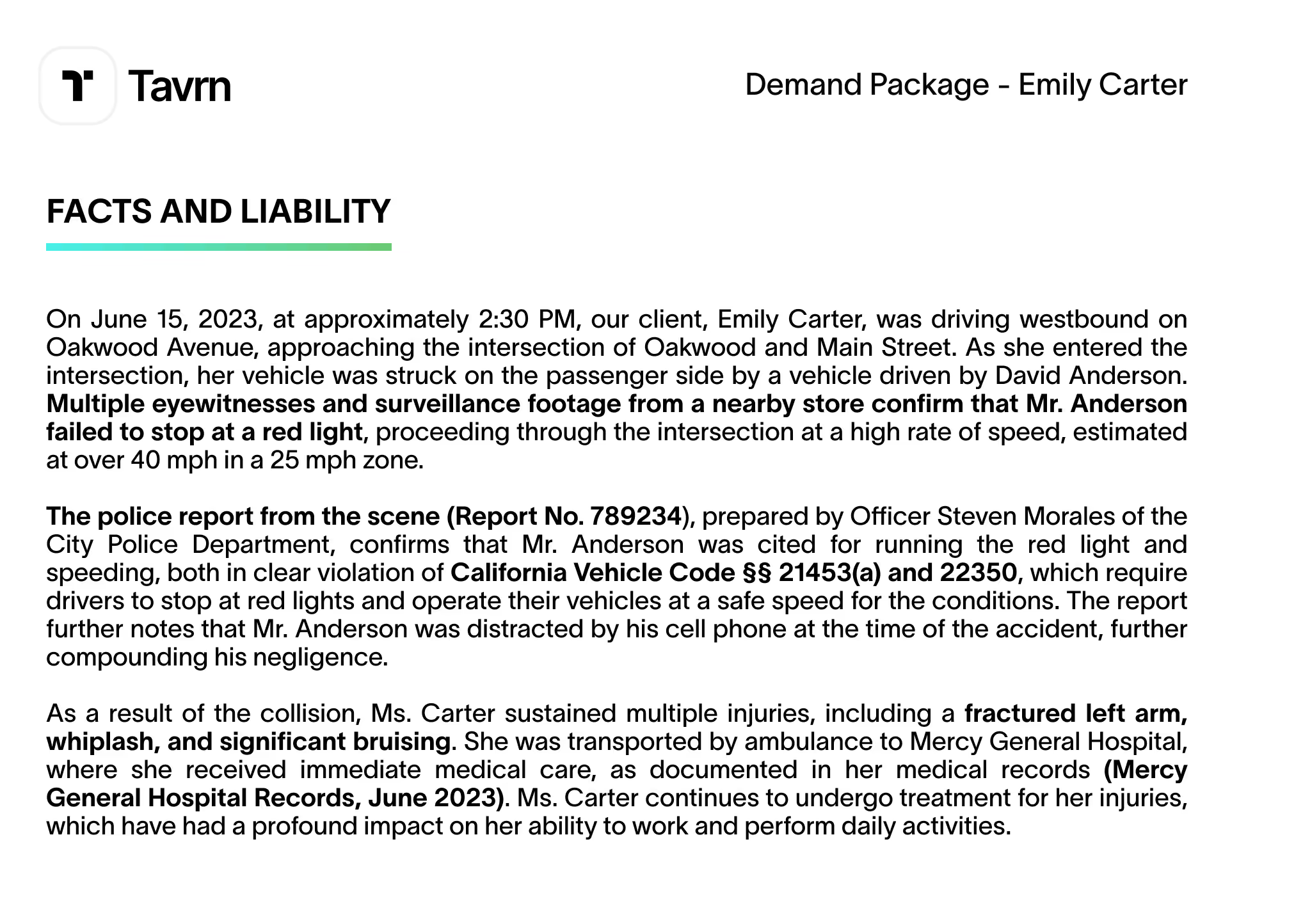How to Write a Winning Settlement Demand Letter for Maximum Compensation
A settlement demand letter isn’t just a request—it's a critical tool for securing fair compensation. It clearly establishes liability, justifies damages, and compels insurers to settle. When structured effectively, it expedites compensation; when poorly written, it invites disputes and undervaluation.
But crafting a persuasive demand letter for settlement takes time. Attorneys must compile medical records, financial losses, and legal arguments—only to risk missing key details that insurers exploit to devalue claims. Even small omissions, such as failing to quantify pain and suffering or overlooking long-term care costs, can weaken negotiations and impact final settlements.
Tavrn’s AI-powered drafting tools eliminate these challenges. They extract key facts, structure arguments, and automatically flag weak spots, reducing work hours while strengthening claims. Instead of spending time formatting and calculating damages, attorneys can focus on strategy and negotiations.
This guide covers everything you need to draft a compelling settlement demand letter—from structuring key sections to avoiding costly mistakes. By the end, you'll know how to draft letters that don't just ask for compensation—they demand it.
Key Components of a Settlement Demand Letter
A settlement demand letter is more than a damage summary—it's a legal argument. Every effective letter should include:
1. Introduction & Statement of Facts
This section established:
- Who was involved (injured party, at-fault party, insurer)
- When and where the incident occurred
- How the opposing party is at fault
Example:
"On June 12, 2023, at 3:15 PM, John Doe was lawfully crossing Main St. and 5th Ave. when Jane Smith ran a red light and struck him. Police and eyewitness reports confirm Smith's responsibility."
Tavrn’s AI-driven tools extract key facts directly from police reports and witness statements, ensuring accuracy and clarity.
2. Injuries & Damages
The letter must outline all injuries, including:
- Physical injuries: Fractures, concussions, spinal trauma
- Emotional distress: PTSD, anxiety, diminished quality of life
- Long-term impairments: Disabilities affecting daily function or employment
Tavrn’s AI processes medical records, ensuring every injury is accurately documented with ICD codes, physician notes, and supporting evidence.
3. Medical Expenses & Financial Losses
- Medical expenses: Hospital stays, surgeries, therapy, medications
- Lost wages & reduced earning capacity: Past and future financial impact
- Ongoing care needs: Rehabilitation, assistive devices, home modifications
Tavrn’s OCR-powered system scans medical bills, payroll records, and financial documents, compiling a complete picture of damages for attorneys.
4. Legal Basis & Liability
To establish fault, the letter must show:
- Negligence: How the at-fault party failed their duty of care
- Causation: Direct link between their actions and the injuries
- Legal Precedent: Relevant statutes or case rulings supporting the claim
Tavrn’s AI-powered legal research tools ensure citations are accurate, relevant, and persuasive.
5. Settlement Demand & Justification
A well-supported demand includes:
- Economic damages: Medical bills, lost wages, future care
- Non-economic damages: Pain and suffering, emotional distress
- Punitive damages: In cases of reckless negligence
Example Calculation:
"Medical expenses: $50,000. Future care: $20,000. Lost wages: $25,000. Applying a pain and suffering multiplier of 3, the total settlement demand is $285,000."
Tavrn’s AI analyzes past settlements and case precedents to recommend strategic, data-backed demand amounts.
6. Deadline & Next Steps
A demand for settlement must:
- Set a firm response deadline (typically 30 days)
- Outline next steps if no agreement is reached (e.g., filing a lawsuit)
- Maintain a professional yet assertive tone
Without a deadline, insurers delay indefinitely. Tavrn automates follow-ups, ensuring attorneys never miss a critical response deadline.
How to Write a Demand Letter for Settlement
A strong demand letter eliminates doubt and compels a fair settlement. It should clearly establish liability, substantiate damages, and present a well-supported request that insurers can't ignore.
Examining a well-structured sample settlement demand letter example can offer valuable insights for crafting a compelling case.
Once you understand the key elements of an effective demand letter, the next steps are:
1. Gather and Organize Supporting Evidence
A well-documented case speeds up negotiations. Attorneys should compile:
- Medical records (physician reports, hospital summaries, diagnostic tests)
- Treatment expenses (bills, therapy costs, prescription receipts)
- Employment verification (pay stubs, tax records, employer statements)
- Accident reports (police records, insurance filings, scene photos)
- Witness statements (testimonies confirming liability and injury severity)
Tavrn’s automation tools extract and organize case data instantly, reducing manual effort and human error.
2. Present a Clear, Factual Account of the Incident
The statement of facts should be concise and evidence-based:
- How the incident happened: Stick to key facts
- Why the other party is at fault: Reference negligence, liability laws, or traffic violations
- What the consequences were: Injuries and medical care required
While every case is unique, examining a sample demand letter for settlement can help frame a compelling argument.
3. Maintain a Professional, Persuasive Tone
Avoid emotional language like:
- Weak: "Your client's reckless behavior caused immense suffering."
- Stronger: "The evidence establishes clear liability for the injuries sustained."
Tavrn’s AI refines legal language maintaining professionalism and credibility.
4. Detail Injuries, Expenses, and Settlement Demand
A well-supported demand includes:
- Specific injury details: ICD codes, physician diagnoses, treatment plans
- Itemized medical costs: Past expenses and projected future care
- Financial losses: Lost wages, reduced earning capacity, future income impact
Tavrn’s AI-driven case analysis tools ensure demand amounts are well-justified.
5. Set a Deadline for Response
A demand letter for settlement must specify:
- Firm response timeframe: Typically 30 days
- Consequences of non-response: Escalation to legal action
A strong demand letter removes doubt and forces a fair settlement.
Common Mistakes to Avoid in Settlement Demand Letters
Even strong claims can be derailed by a poorly executed settlement demand letter. Common mistakes include:
1. Weak or Missing Documentation
A demand letter should eliminate any opportunity for insurers to dispute the claim. Missing records give adjusters leverage to challenge injury severity, question treatment necessity, or reduce compensation. Commonly overlooked documents include:
- Comprehensive medical records: Every provider, every visit, every treatment.
- Wage verification: Pay stubs, tax records, employer statements.
- Photo/video evidence: Accident scenes, visible injuries, property damage.
Weak Example: "The claimant sustained severe injuries requiring treatment."
Stronger Version: "Medical reports confirm a right tibia fracture requiring open reduction and internal fixation surgery, resulting in an eight-month recovery with extensive physical therapy."
2. Vague or Incomplete Injury Descriptions
Insurers scrutinize medical claims. Generalized injury descriptions invite skepticism. Every injury should include:
- Precise medical terminology: "C4-C5 disc herniation with nerve impingement," not just "back pain"
- ICD codes and physician statements: Adds credibility
- Impact on daily life: Justifies pain and suffering claims
3. Overstating or Undervaluing the Settlement Demand
An excessive demand stalls negotiations. An undervalued demand leaves money on the table. Attorneys should:
- Accurately total medical costs, lost wages, and future care.
- Use industry-standard multipliers for pain and suffering.
- Compare similar settlements to justify demands.
4. No Clear Response Deadline
Without a firm deadline, insurers have no urgency to act. Every letter must specify:
- A firm response timeframe (typically 30 days).
- Consequences of non-response (e.g., escalation to litigation).
Weak Example: "Please respond when possible."
Stronger Version: "Provide a written response by [specific date]. We will proceed with legal action without further notice if no response is received."
Tavrn eliminates these pitfalls by generating clear, professional, and fully structured demand letters in minutes. Automated OCR technology scans medical records, reducing human error and ensuring all critical details are included. AI-driven formatting guarantees legal professionalism, preventing costly mistakes that could weaken your case.
Maximize Your Settlements with AI Demand Letters from Tavrn
A demand letter is more than paperwork—it's leverage. A strong letter sets the terms, justifies damages, and pressures insurers to settle. A weak one will delay negotiations, invite disputes, and lead to lowball offers.
However, manual drafting is slow, inconsistent, and prone to errors. Tavrn’s AI-powered demand letter solution transforms the process, cutting drafting costs by up to 90% and delivering fully structured demand letters within 24 hours.
Tavrn's AI-driven tools:
- Extracting key details from medical records, wage statements, and accident reports
- Analyzing past settlements to recommend strategic demand amounts
- Structuring letters professionally, ensuring clarity and logical flow
- Detecting inconsistencies and missing documents, preventing insurer pushback
Attorneys using Tavrn resolve cases faster, negotiate stronger, and secure higher settlements—without compromising accuracy.
Don’t let paperwork slow your case down. Get fast, accurate, and AI-powered demand letters from Tavrn. Start your free trial today.
Settle quicker and for more with Tavrn's AI-powered products now.
